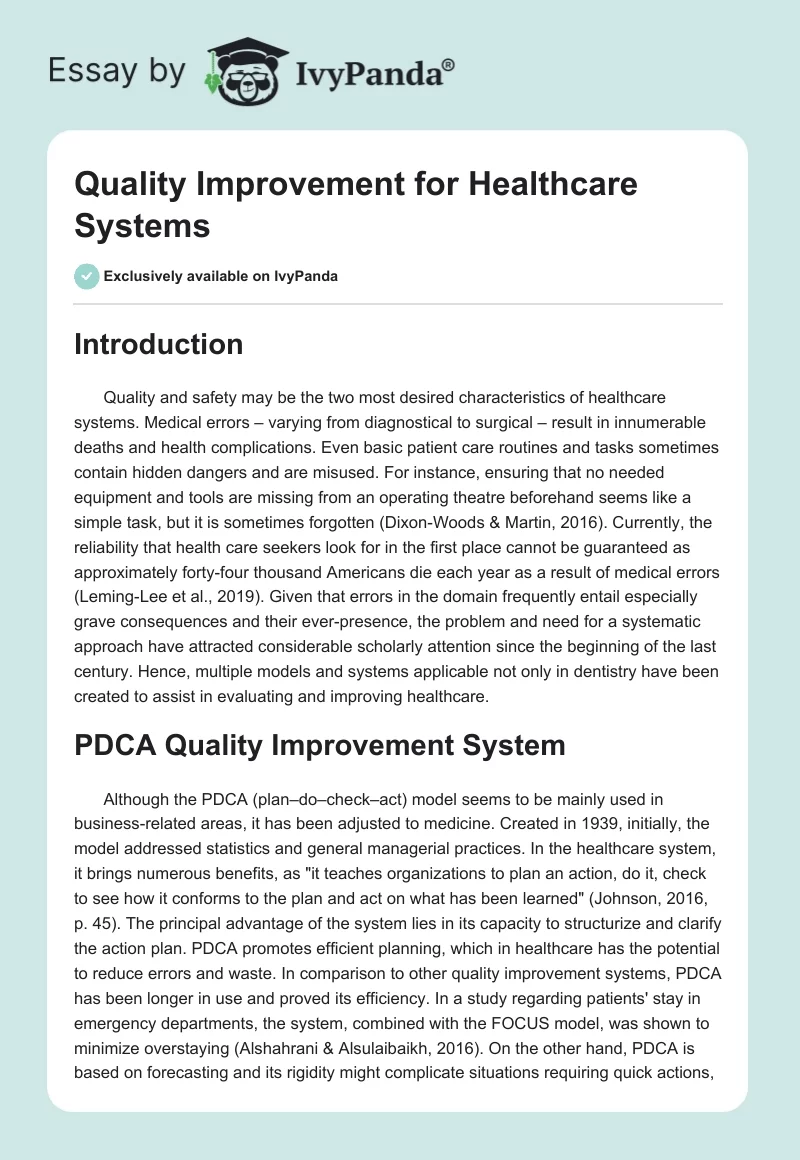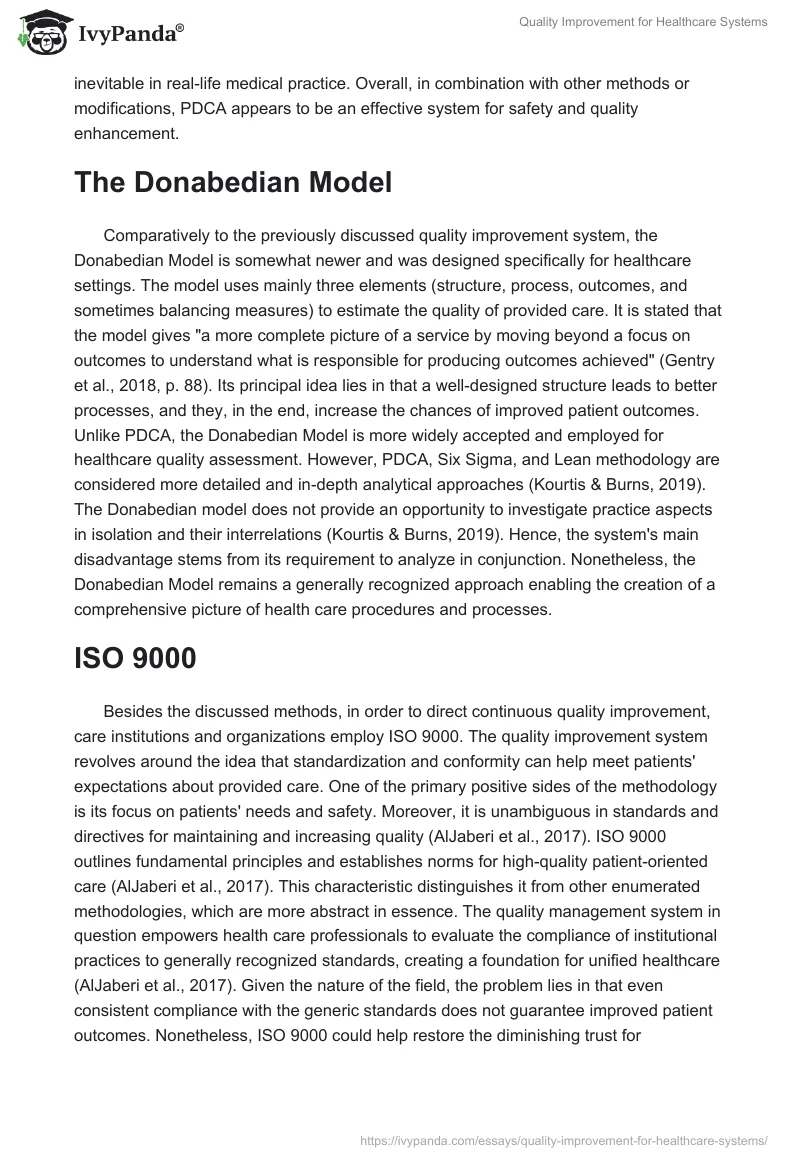Introduction
Quality and safety may be the two most desired characteristics of healthcare systems. Medical errors – varying from diagnostical to surgical – result in innumerable deaths and health complications. Even basic patient care routines and tasks sometimes contain hidden dangers and are misused. For instance, ensuring that no needed equipment and tools are missing from an operating theatre beforehand seems like a simple task, but it is sometimes forgotten (Dixon-Woods & Martin, 2016). Currently, the reliability that health care seekers look for in the first place cannot be guaranteed as approximately forty-four thousand Americans die each year as a result of medical errors (Leming-Lee et al., 2019). Given that errors in the domain frequently entail especially grave consequences and their ever-presence, the problem and need for a systematic approach have attracted considerable scholarly attention since the beginning of the last century. Hence, multiple models and systems applicable not only in dentistry have been created to assist in evaluating and improving healthcare.
PDCA Quality Improvement System
Although the PDCA (plan–do–check–act) model seems to be mainly used in business-related areas, it has been adjusted to medicine. Created in 1939, initially, the model addressed statistics and general managerial practices. In the healthcare system, it brings numerous benefits, as “it teaches organizations to plan an action, do it, check to see how it conforms to the plan and act on what has been learned” (Johnson, 2016, p. 45). The principal advantage of the system lies in its capacity to structurize and clarify the action plan. PDCA promotes efficient planning, which in healthcare has the potential to reduce errors and waste. In comparison to other quality improvement systems, PDCA has been longer in use and proved its efficiency. In a study regarding patients’ stay in emergency departments, the system, combined with the FOCUS model, was shown to minimize overstaying (Alshahrani & Alsulaibaikh, 2016). On the other hand, PDCA is based on forecasting and its rigidity might complicate situations requiring quick actions, inevitable in real-life medical practice. Overall, in combination with other methods or modifications, PDCA appears to be an effective system for safety and quality enhancement.
The Donabedian Model
Comparatively to the previously discussed quality improvement system, the Donabedian Model is somewhat newer and was designed specifically for healthcare settings. The model uses mainly three elements (structure, process, outcomes, and sometimes balancing measures) to estimate the quality of provided care. It is stated that the model gives “a more complete picture of a service by moving beyond a focus on outcomes to understand what is responsible for producing outcomes achieved” (Gentry et al., 2018, p. 88). Its principal idea lies in that a well-designed structure leads to better processes, and they, in the end, increase the chances of improved patient outcomes. Unlike PDCA, the Donabedian Model is more widely accepted and employed for healthcare quality assessment. However, PDCA, Six Sigma, and Lean methodology are considered more detailed and in-depth analytical approaches (Kourtis & Burns, 2019). The Donabedian model does not provide an opportunity to investigate practice aspects in isolation and their interrelations (Kourtis & Burns, 2019). Hence, the system’s main disadvantage stems from its requirement to analyze in conjunction. Nonetheless, the Donabedian Model remains a generally recognized approach enabling the creation of a comprehensive picture of health care procedures and processes.
ISO 9000
Besides the discussed methods, in order to direct continuous quality improvement, care institutions and organizations employ ISO 9000. The quality improvement system revolves around the idea that standardization and conformity can help meet patients’ expectations about provided care. One of the primary positive sides of the methodology is its focus on patients’ needs and safety. Moreover, it is unambiguous in standards and directives for maintaining and increasing quality (AlJaberi et al., 2017). ISO 9000 outlines fundamental principles and establishes norms for high-quality patient-oriented care (AlJaberi et al., 2017). This characteristic distinguishes it from other enumerated methodologies, which are more abstract in essence. The quality management system in question empowers health care professionals to evaluate the compliance of institutional practices to generally recognized standards, creating a foundation for unified healthcare (AlJaberi et al., 2017). Given the nature of the field, the problem lies in that even consistent compliance with the generic standards does not guarantee improved patient outcomes. Nonetheless, ISO 9000 could help restore the diminishing trust for healthcare – by defining the threshold of adequate care, the quality improvement system seeks to guarantee increased patient experience in healthcare institutions.
Lean Methodology
Lean methodology has been seemingly more and more adopted in the domain. The ultimate goal of this system’s usage, and of the ones mentioned above, is increasing profitability and sustainability by previously improving patient satisfaction, clinical results, safety, and staff’s performance (D’Andreamatteo et al., 2015). Several influential organizations advocated for its usage over the years, including the Institute for Healthcare Improvement in the USA and the Institution for Innovation and Improvement in the United Kingdom. Similarly to the standards of ISO 900, this quality improvement system is openly patient-directed. The methodology’s utilization yields considerable results, such as decreasing waste, costs, and more efficient interactions with patients. The reduction in medical waste seems to be a common outcome for quality improvement systems that prioritize planning (PDCA is comparable in this aspect). In the case of Lean methodology, the feature arises from the methodology’s history: initially, it was indented for Toyota mass production during a financial crisis that resulted in scarce resources (Leming-Lee et al., 2019). This feature renders Lean methodology more relevant in times when sustainability gains greater importance in the health industry.
Furthermore, the quality improvement system is designed to deal with multiple issues that potentially result in medical errors. Needless transportation, unreasonable motions, delays, excess inventory, and overproduction can create confusion among medical staff that directly influences patients’ well-being and safety. In healthcare institutions, Lean methodology has subtypes and branches that encourage clutter-free working spaces, simplified inventories, and housekeeping norms to prevent detrimental confusion and disorientation (D’Andreamatteo et al., 2015). Specifically, the Lean 5S tool process serves to ensure that surgical procedures flow without interruptions, which is achieved by systemization of work routines (D’Andreamatteo et al., 2015). The methodology involves sorting, setting in order, systematizing, and sustaining items and work areas. Lean methodology differs from ISO 9000 and the Donabedian Model in its complete focus on minimizing waste, attitude towards tools, and order, which may be caused by its initial sphere of application. These characteristics help institutions that apply Lean methodology decrease cases of contamination and equipment being out of service. Therefore, the progressively more wide-spread implementation of this quality improvement system in a healthcare setting is justified by the alignment of its central principles with the ones of medicine.
Six Sigma
The last considered method, Six Sigma, similarly to PDCA, the Donabedian Model, and Lean methodology, represents a cycle of repeated procedures. Comparatively to Lean methodology, Six Sigma is not designed principally to reduce waste and organize but diminish defects and variations. The combination of the two models, Lean Six Sigma, exists and reflects their best qualities. It is argued that Six Sigma alone has been associated with significant benefits for medical institutions, namely, enhanced competitive advantage and minimization of financial problems (Deniz & Çimen, 2018). Six Sigma could also result in reduced wait time and prescription errors. Simultaneously, the method may produce rigidity and lower the staff’s creativity (Deniz & Çimen, 2018). This possible impact can be related to how the technique “binds all operational activities together, and it also links between the strategic level and the operational level in private hospital” (Ahmed et al., 2018, p. 12). In contrast to, for example, PDCA or Lean methodology, Six Sigma could be less recognized in healthcare (Deniz & Çimen, 2018). Conclusively, the method appears to be the best applied alongside Lean methodology.
PDCA in Dentistry
The importance of hand hygiene in medicine in general and dentistry specifically is difficult to overestimate. That is partially why Chen et al. (2016) devoted their article “Role of Quality Control Circle in sustained Improvement of Hand Hygiene Compliance” to the issue. The researches employed a QCC program based on PDCA in a stomatology hospital in Shandong, China, to increase hand hygiene compliance. The article outlines the positive impact that PDCA, along with the QCC program, brought. Notably, it is declared that “hand hygiene compliance rates improved over time, with significant improvement between preintervention (60.1%) and postintervention (97.2%) periods (P < 0.001)” (Chen et al., 2016, p. 1). Additionally, the method’s incorporation revealed that female medical professionals, nurses specifically, adhered more strictly to the rules than their male colleagues (Chen et al., 2016). Generally, the article exemplifies the beneficial consequences of incorporating PDCA in a dental clinic.
The article demonstrates how the quality improvement system can be applied in dentistry, but its possibilities are not limited to ensuring hand hygiene. For example, the method can be employed in the management of private clinics to control the stock of materials, improving its distribution. Dental materials maintain a clinic’s capacity to operate and influence its final expenditures. It is instrumental to handle dental materials with care to reduce costs, and PDCA could assist in restructuring how they are managed. More specifically, the method can be used to track the inventory in a clinic, planning and correcting its further spread. Thus, PDCA can be viewed as a strategic management tool in dental setting, especially with regard to inventory management, which is seemingly a common issue.
Conclusion
Although the compared quality improvement systems demonstrate that increasing attention to the issue initially began in manufacturing, it has considerably affected the health industry. Safety and quality are patients’ principal concerns and determinants of their experience, but, currently, they cannot be fully guaranteed. In dentistry, medical errors resulting from improper equipment, mistakes in patient errors, or prescriptions directly affect individuals’ well-being. Despite the differences and some of the disadvantages of the discussed methods, incorporating any of them, could lead to sizable advancements in medical practice.
References
Ahmed, S., Abd Manaf, N. H., & Islam, R. (2018). Effects of Six Sigma initiatives in Malaysian private hospitals. International Journal of Lean Six Sigma, 12-15. Web.
AlJaberi, O. A., Hussain, M., & Drake, P. R. (2017). A framework for measuring sustainability in healthcare systems. International Journal of Healthcare Management, 1–10. Web.
Alshahrani, M., & Alsulaibaikh, A. (2015). Effects of implementation of FOCUS-PDCA model to decrease patients’ length of stay in emergency department. Al-Azhar Assiut Medical Journal, 13(4), 189–190.
Chen, P., Yuan, T., Sun, Q., Jiang, L., Jiang, H., Zhu, Z., … Xu, A. (2016). Role of quality control circle in sustained improvement of hand hygiene compliance: an observational study in a stomatology hospital in Shandong, China. Antimicrobial Resistance & Infection Control, 5(1), 1–6. Web.
D’Andreamatteo, A., Ianni, L., Lega, F., & Sargiacomo, M. (2015). Lean in healthcare: A comprehensive review. Health Policy, 119(9), 1197–1209. Web.
Deniz, S., & Çimen, M. (2018). Barriers of six sigma in healthcare organizations. Management Science Letters, 885–890. Web.
Dixon-Woods, M., & Martin, G. P. (2016). Does quality improvement improve quality?. Future Health, 3(3), 103–108.
Gentry, S. V., Powers, E. F. J., Azim, N., & Maidrag, M. (2018). Effectiveness of a voluntary family befriending service: a mixed methods evaluation using the Donabedian model. Public Health, 160, 87–93. Web.
Johnson, C. N. (2016). The benefits of PDCA. Quality Progress, 49(1), 45.
Kourtis, S. A., & Burns, J. P. (2019). Frameworks for quality improvement in pediatric intensive care: A concise review. Pediatric Investigation, 3(2), 117–121. Web.
Leming-Lee, T. “Susie,” Polancich, S., & Pilon, B. (2019). The application of the Toyota production system LEAN 5S methodology in the operating room setting. Nursing Clinics of North America, 54(1), 53–79. Web.


